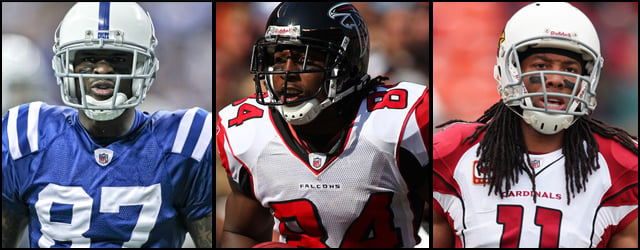On Target
It’s no secret that if you wish to be competitive in your league, you can’t ignore the receiver position as a critical point toward your ultimate success.
Whether in your initial draft (we all know how easy it is to focus on young running backs) or following, identifying, acquiring and maintaining a stable of WR1s, both current and future, is one of your goals. Going one step further, especially in PPR leagues, a deep selection of productive receivers can elicit healthy trade value to those who didn’t prepare as well.
When surveying the wide receivers, the first place I look isn’t at fantasy points or touchdowns. Instead, I start at targets and work my way backwards. There is no better indication about a receiver’s role in the offense than through his target numbers. While the number of targets don’t guarantee fantasy production in every case, targets and fantasy points per game (fppg) often do go hand in hand. Find those receivers who can translate those targets into a high percentage of receptions and you likely have also found your highest scoring group. Find those with a sub-par reception percentage and you potentially have a nice sleeper should the receiver/quarterback gain experience or should other factors translate into a higher percentage of receptions.
In most cases, few surprises filter to the top, while the big names still are just where you would expect them to be. However, as you continue to move down the list, surprising names often can be found.
The Following is a list of the top thirty targeted receivers of 2010, followed by the number of targets, receptions and reception percentage through week sixteen of last year (week seventeen not taken into account due to its inaccurate competitive nature):
The Top Ten
1. Roddy White – 171 targets/109 catches/63.7% reception percentage
2. Reggie Wayne – 166/102/61.4%
3. Larry Fitzgerald – 156/79/50.6%
4. Brandon Lloyd – 139/72/51.8%
5. Terrell Owens – 139/72/51.8%
6. Andre Johnson – 138/86/62.3%
7. Calvin Johnson – 137/77/56.2%
8. Santana Moss – 133/84/63.2%
9. Brandon Marshall – 132/81/61.4%
10. Marques Colston – 131/84/64.1%
The Second Ten
11. Hakeem Nicks – 128/79/61.8%
12. Chad Ochocinco – 125/67/53.6%
13. Dwayne Bowe – 123/67/54.5%
14. Wes Welker – 123/86/69.9%
15. Mike Williams (TB) – 122/61/50%
16. Danny Amendola – 119/83/69.7%
17. Davone Bess – 117/77/65.8%
18. Steve Johnson – 117/77/65.8%
19. Miles Austin – 115/67/58.3%
20. Greg Jennings – 114/72/63.2%
The Final Ten:
21. Jeremy Maclin – 114/70/61.4%
22. Jabar Gaffney – 109/64/58.7%
23. Anquan Boldin – 106/62/58.5%
24. Pierre Garcon – 106/60/56.6%
25. Eddie Royal – 104/59/56.7%
26. Mike Williams (SEA) – 102/62/60.8%
27. Braylon Edwards – 99/52/52.5%
28. Steve Smith (CAR) – 99/46/46.5%
29. Derek Mason – 97/58/59.8%
30. Mike Thomas – 96/65/67.7%
After surveying these numbers, a few things stand out.
The top ten receivers are a bit of a mixed bag, at least when looking at completion percentage. Many believe that Roddy White cannot reproduce his 2010 campaign and looking at his targets and rate of completion, it’s hard to argue that he would or could, especially with the arrival of Julio Jones.
Looking further, many of the usual suspects are listed, but #3 through #5 sport a significantly less completion rate. Not surprisingly, those with less than ideal quarterback situations lag the group by as much as ten percent. For Larry Fitzgerald in particular, this likely represents his floor and any better play at quarterback could spike his numbers in excess of 10%.
We also know that T.O. is gone from Cincinnati and will fall out of this grouping (never say never) and we believe that Brandon Lloyd will not repeat last year’s success. To Lloyd’s credit however, note that he put together his monster 2010 campaign with a low completion percentage. Could we be wrong and could Lloyd have ten percent upside with more stable quarterback play? We still think not, but the numbers foretell the possibility if his targets remain the same.
Looking into the second grouping, we see an interesting range and some surprising names. Danny Amendola (#16) and Davone Bess (#17), at least using targets as a metric, are being undervalued. That said, their 69.7% and 65.8% completion percentage, respectively, suggest that their numbers have likely peaked unless more targets come their way – an unlikely scenario in both cases.
Amendola is clearly the Rams WR1 and may be able to reproduce these numbers with a more experienced Sam Bradford under center. As for Bess, while number two behind Brandon Marshall and very much in a Wes Welker role, he’s likely to produce again at this level. For my money, however, Tampa Bay’s Mike Williams looks like the player from this group who could be in for a leap into the top ten overall. At a 50% completion percentage and in his second year with rising quarterback Josh Freeman, Williams makes an ideal target this off-season, no pun intended.
Beyond Mike Williams, Dwayne Bowe and Miles Austin catch my eye. Some are forecasting a decline in numbers for Bowe, but there appears to be upside given his completion percentage of 54.5%. Touchdowns aside, I’m looking for increased targets and a five to ten point increase in reception percentage for Bowe in 2011, with TDs remaining strong. The loss of Tony Romo affected Austin without a doubt. Many believe that the arrival of one Dez Bryant was to blame for Austin’s less than stellar 2010, but I’m forecasting 15-20 additional targets for Austin along with a 5% increase in completion percentage, Romo still looks for Austin first.
Looking at our third grouping, a couple of things stand out there as well. Completion percentage is relatively stable, Braylon Edwards and Steve Smith being the exceptions. For Edwards, too much is up in the air to even hazard a guess as to whether he’s likely to see an increase, or decrease, in his 2011 production. For Steve Smith, however, his ridiculously low 46.5% completion rate is quite likely his floor. Whether Smith leaves Carolina or not, I doubt we will see that rate again and Smith is being undervalued across the board. In the right situation, Smith could easily see a 20% increase in targets, raising his production nicely. Look for Smith to depart to a contender shortly after the new CBA is signed. He makes a nice fantasy addition now.
For this exercise, you can go as deep as you like (I usually go to 60). Many times, finding departing WR1s and locating their heir apparent by using this target exercise can produce great results. Keep your eye on low completion percentage as it relates to less-than-ideal quarterback situations. If the quarterback or receiver is young, experience will likely pay off in subsequent years and completion percentage will rise. Nothing is more important than the pure number of targets because a rising tide lifts all boats and, in this exercise, targets indicates trust and role – both factors that dictate ultimate production.
- Lineup Advice: Wrap-up, Thank You and Goodbye (TTFN) - January 1, 2024
- Lineup Advice: Week 17 – Championship Edition - December 26, 2023
- Lineup Advice: Week 16 – The “What is” Edition - December 19, 2023



































































